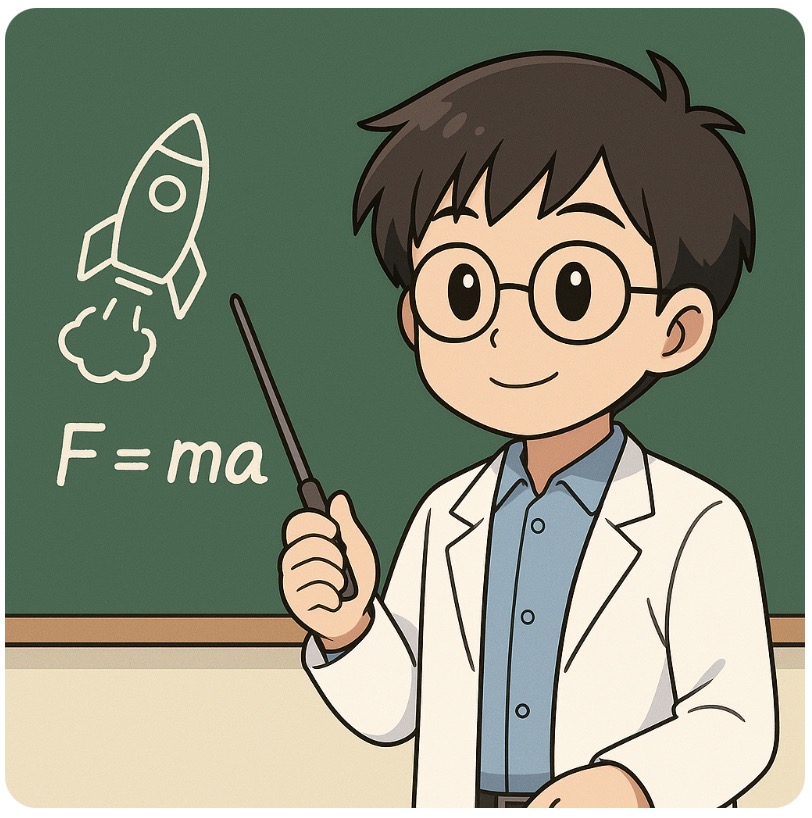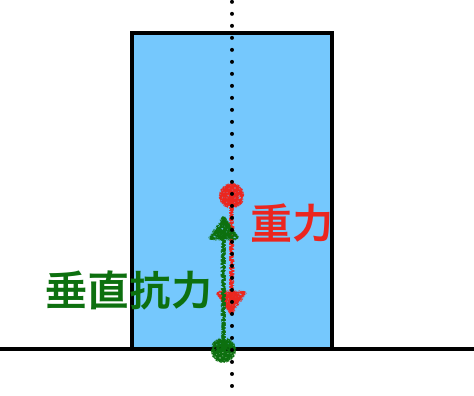From Tablecloth Tricks to Rockets! The Fascinating World of the “Equation of Motion”
I’m Ken Kuwako, a science trainer. Every day is an experiment.

Equation of Motion: F=ma
This article is also available as a podcast!
Have you ever seen the formula “F = ma”? It’s the equation of motion, one of the most famous formulas in high school physics.
We use the word “force” every day, but what exactly is it? For example, could you explain “force” in simple terms to a small child? This is the first question I ask my students in class. It’s surprisingly difficult to describe an intangible concept like “force” with just words. However, the equation of motion was created precisely to define what force is.
Imagine this. You’re on an ice-skating rink, and you, being a bit of a prankster, give a child a push from behind. The child glides forward smoothly, right? This shows that the “force” you applied changed (accelerated) the child’s velocity. The “F” on the right side of the equation of motion represents the force applied, and the “a” on the left side represents acceleration. In other words, the equation of motion defines that “force is the ability to accelerate an object.”
Besides “F,” this equation also includes the symbol “m,” which stands for mass. Why is mass relevant? Let’s go back to the same ice rink and this time, push a heavier adult instead of the child. You’ll find it’s harder to get the adult moving, meaning they accelerate less. This is because acceleration “a” and mass “m” are inversely proportional.
If you solve the equation of motion (F = ma) for acceleration (a), you get the following:
Looking at this equation, it’s obvious that since mass (m) is in the denominator, the larger the mass, the harder it is to accelerate.
The Unit of Force: The Newton
In our daily lives, we have an intuitive sense of how strong a force is. But since this feeling is subjective, we can’t compare forces accurately. That’s why in the world of physics, the equation of motion is used to define the magnitude of force.
A Newton (N) is defined as the force required to accelerate a 1 kg object at a rate of 1 m/s².
It’s important to have a feel for what a “Newton” is. Let’s look at some common examples:
- 10 N (Newtons): The weight you feel when holding a carton of milk (1 kg) is approximately 10 N.
- 1 N (Newton): The force you feel when holding a single AA battery (about 100 g) is approximately 1 N.
How to Use the Equation of Motion to Solve the Mysteries of the Universe
■ The Balance of Forces
An apple resting on a desk is acted upon by two forces: gravity (W) and the normal force (N). The normal force might be an unfamiliar term. If you stand on the floor for a long time, your feet start to hurt, right? This is because the floor is pushing up on your feet to support your weight. This upward force is the normal force. An apple “standing” on a desk, just like us, is also subject to the normal force.

Let’s use the equation of motion to understand the magnitude of these two forces. The apple on the desk is at rest. This means its acceleration (a) is 0. Substituting a = 0 into the equation of motion gives us:
However, this doesn’t mean that no force is acting on the apple. The “F” in the equation of motion actually represents the “net force,” which is the sum of all forces acting on an object. F = 0 means that all the forces acting on the apple at that moment are canceling each other out, leaving no net force.
From this, we can see that the magnitude of gravity and the normal force are equal.
Forces of equal magnitude are canceling each other out, resulting in a net force of zero. This is called the “balance of forces.” An object at rest has zero acceleration, so its forces must always be in balance.
Similarly, let’s imagine we put this apple in water, and it floats motionless. Since it’s at rest, the forces must be balanced. However, it’s not on a desk, so there’s no normal force. Gravity still acts on it, pulling it downward. So, what is the upward force that balances gravity in this case?

The answer is buoyancy. In water, an object receives an upward force called buoyancy, which is created by water pressure. From the balance of forces, if the apple’s weight is 1 N, the buoyant force must also be 1 N.
When you look around with the mindset that “an object at rest must always be supported by some force,” you’ll start to notice various forces, and it becomes quite interesting.
There are also cases where forces can be balanced even if the object is not at rest. Try to imagine a situation where acceleration is zero but the object is still in motion.
Zero acceleration means the velocity isn’t changing. This means that when an object is moving at a constant velocity, the sum of all forces is zero. For example, a curling stone glides across the ice at a constant speed. At this point, there are almost no forces on the stone besides gravity and the normal force, so the sum of the forces is zero.
Here’s a video of a homemade hovercraft.
In this way, if no force acts on an object, it will continue the motion it started with. This property is called “inertia.” You can even think of a state of rest as a constant-velocity motion with a velocity of zero.
■ When Forces Are Unbalanced
What would happen if you slid a curling stone on a carpet instead of on ice? Naturally, its speed would quickly decrease and it would eventually stop.
Let’s look at the equation of motion (F = ma) again. “a” is acceleration, which means a change in velocity. On the carpet, the stone is decelerating, so its acceleration is in the opposite direction of its motion. This means there is a force acting on the stone in that opposite direction. What kind of force could be acting on the stone?
You’ve probably guessed it. The culprit is friction. The force of friction “f” acts in the opposite direction, causing the stone to slow down.
What if there were no friction? If no force acts on an object, it cannot decelerate. The stone would continue to move at the same speed it was given initially. The same principle applies to comets that fly through space forever. They continue to move without an engine because there are no forces like friction or air resistance to impede their motion in space.
Newton’s Three Laws of Motion
The scientist Isaac Newton summarized the principles of force and motion into three laws, which he called the “Laws of Motion.”
The ancient scholar Aristotle believed that the natural state of an object was rest, and that a continuous force was required to keep it in motion. This idea aligns with our everyday experience that “things stop if you leave them alone.” However, 1,700 years later, the Italian physicist Galileo Galilei argued against this.
Galilei proposed that “if there were no air resistance or friction, an object would continue to move without changing its speed.” Newton adopted this idea as the Law of Inertia, or his First Law of Motion.
The Second Law of Motion is the “Law of Acceleration,” which is precisely the equation of motion (F = ma). The core of this law is the connection it establishes between “force” and “acceleration,” unlike Aristotle’s view.
Finally, the Third Law of Motion is the “Law of Action-Reaction.” For example, let’s consider a mischievous kindergarten student, A, who headbutts another student, B.
It’s natural for student B to get a painful bump on their head from being headbutted, but student A will also get a bump on their head. In this way, when two objects exert force on each other, a pair of forces always appears. This pair is called the “action force” and “reaction force,” and these two forces are equal in magnitude and opposite in direction.
Here’s a video showing the Law of Action-Reaction in a weightless environment.
We use the law of action-reaction unconsciously in our daily lives. When you turn in a swimming pool, you kick the wall with force, and by using the reaction force, you move in the opposite direction. Similarly, a bottle rocket gains forward thrust by expelling water backward, using the reaction force. The same principle applies to real rockets that go into space: they accelerate by expelling gas backward and using the reaction force.
By effectively using the law of action-reaction, you can easily create a rocket from two 500ml plastic bottles that can fly up to 30 meters.
■ Inertia and the Tablecloth Trick
When a carpenter wants to remove a blade from a hand plane, they tap the body of the plane with a hammer. Why do they hit the body to remove the blade?
Mass is a measure of an object’s “resistance to motion,” or the strength of its inertia. By tapping the lighter wooden body of the plane instead of the heavier metal blade, the same force can cause the body to accelerate sharply. The blade, thanks to its inertia, wants to stay put, causing it to loosen and come out.
You’ve also probably seen on TV a street performer who pulls a tablecloth out from under a wine glass so quickly that the glass remains in place without toppling over. This is also a trick that utilizes the inertia of the glass. The tablecloth trick and the “daruma otoshi” (a Japanese game of stacking blocks) are great examples of how to cleverly use the property of inertia.
※ This article was written as a bonus for my book, “High School Physics Review for Adults.” You can also read other articles about the book here.
“High School Physics Review for Adults” (Amazon link)
Contact & Requests
Make the wonders and fun of science more accessible! We’ve compiled fun science experiments you can do at home and easy-to-understand tips. Feel free to search around!
・About the administrator, Ken Kuwako: here
・For various requests (writing, lectures, science workshops, TV supervision, appearances, etc.): here
・Article updates are delivered on X!
![]() The Science Fun Channel is currently distributing experiment videos!
The Science Fun Channel is currently distributing experiment videos!



